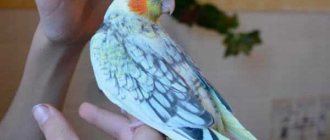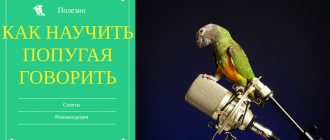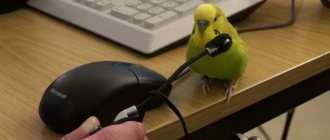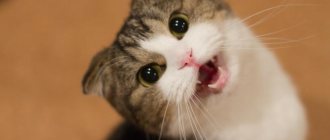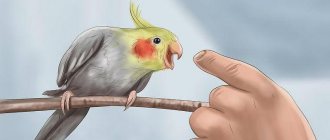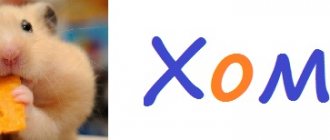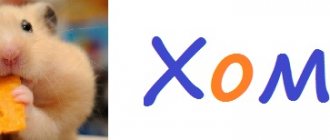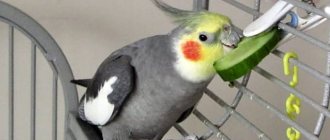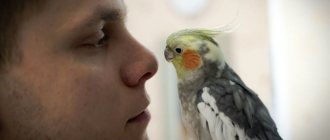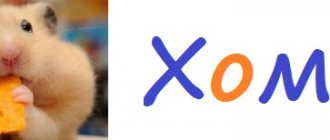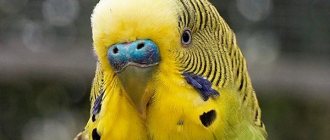The Corella parrot is considered a unique bird that can be kept at home. Nature has rewarded them with amazing abilities and intelligence, which allows them to quickly memorize sounds and human speech. When you hear how a cockatiel talks, you will immediately be surprised that the bird pronounces all the letters and sounds correctly and without errors. But still, teaching her this will require a lot of work and patience. Proper organization of the process is important, which will help the parrot remember a large number of words and sentences.
Features and character of a parrot
If you have a Corella, be prepared to give him a lot of attention.
Corella is a bird with character. The parrot does not tolerate neglect of its own person and requires increased attention. The bird takes root in the house and begins to show abilities only after it feels like a member of the family.
A feature of the Corella parrot's character is its attachment to its owner. The bird establishes close contact with only one family member, most often a woman. The bird completely gets used to home conditions and all the inhabitants of the house in the second year of life.
The process of raising a parrot must begin with taming. Young individuals are the easiest to tame. The older the bird, the more difficult it will be to establish contact with it and teach onomatopoeia skills.
Contact with the bird is fundamental. The bird will not repeat words after a person who is unpleasant to it. Once your friendship with Corella has been established, you can begin training.
Only a lonely bird can learn to speak. If several parrots live in a house, they will communicate with each other in their own language. In this case, the parrot will not repeat the words after the owner.
Determination methods
The poultry hobbyist should only buy young birds if he wants to:
This is where many novice amateurs make mistakes. They are associated both with direct deception on the part of sellers who sell an old parrot under the guise of a young one, and with the mistakes of the buyer who does not know how to correctly determine the age of the bird. Often even novice sellers do not know how to do this. It also happens that a seller who has a lot of poultry products gets confused and sells an already mature bird as a young one.
There is only one way out of the situation - to determine the age of the cockatiel parrot immediately before purchasing. This can be done based on a number of external signs. The color of young and old birds differs little, so you need to look very carefully. The practical experience of many generations of poultry farmers suggests a number of ways to determine the age of cockatiels. All of them take into account the differences between a young parrot and an old one in small details.
On the head
This part of the body contains organs, by the appearance of which one can try to determine the approximate age of the bird being examined. These are the eyes, beak and crest.
By the eyes
How to find out the age of a cockatiel parrot by its eyes? You need to take a close look at their color. The eyes of young parrots shine, their color has a brownish tint. Their irises are black. Adult parrots have dull eyes. As the bird gets older, they gradually darken and eventually turn black. The iris of adults is brown. As life goes on, it becomes more and more clear.
By the crest
When buying a new bird, you should pay close attention to the condition of the plumage of its head. The head of a young cockatiel has the following characteristic features:
If the bird is already mature, then the ends of the feathers of its crest are slightly curved. There may be an open area of skin under the tuft.
By beak color
Another marker is the color of the parrot's beak. In chicks it is pale pink, with a light wax. In adult birds it becomes dark gray over time. In addition, the beak of adult parrots is much larger.
By paws and claws
You can determine the approximate age of a cockatiel by paying close attention to its paws and claws. The claws of young birds are small, with a pinkish tint. With age, the claws grow and become darker, acquiring a grayish tint during the life of the bird.
The chicks' feet are pinkish. There are no cracks on their surface. The feet of six-month-old birds are darker, with pronounced horny scales and cracks on their surface.
By plumage
You can determine approximately how long a bird has lived by the state of its plumage. It is completely different for chicks and mature cockatiels.
The chicks have not yet gained life experience and do not know how to care for their feathers at all. They are disheveled, there may be bird droppings on them, which young birds do not yet know how to clean off. A short tail and dull feather color also indicate that the parrots are barely fledged.
In adult parrots, the plumage looks much more beautiful. It is quite brightly colored. It is well-groomed, as the birds love and know how to clean it. The tail of adult cockatiels is much longer than that of juveniles.
At about 4 months of age, the chicks begin to molt. They develop beautiful plumage at the age of about 6 months. Therefore, molting is one of the signs of an individual’s youth. But adults can also shed if they suffer from infectious diseases.
By singing
Young birds cannot sing. They master this task by about the age of 6 months. Adult parrots sing very beautifully. Therefore, if a bird sings well enough, it means it is no longer a chick.
By behavior
The behavior and movements of young birds differ from those of adult birds. Young parrots fly poorly or do not yet know how to do it at all. They sleep, leaning on a perch with two paws, or even sitting on the bars of the cage. It is still difficult for them to maintain balance. Very old cockatiels can sleep in the same position, and a potential parrot buyer should remember this. Adult pets usually sleep leaning on a perch with only one paw.
When to start studying
When your pet is 35–40 days old, you can begin training
It is advisable to determine the ability to reproduce human speech when choosing a chick during purchase. The gifted chick doesn’t just squeak, it changes the tone of its voice and makes various other sounds.
Interesting: How to accustom a parrot to your hands
Chicks begin to learn speech at the age of 35–40 days. At this time, the bird is most receptive to everything new, so the process of memorizing words occurs quickly. The parrot pronounces its first words 2–2.5 months after the start of classes.
Plumage color
As they grow older, all parrots go through a juvenile molt - a radical change in plumage. The inconspicuous baby fluff sheds, and is replaced by dense, richly colored feathers. In cockatiels, this occurs between 8 and 12 months. Usually, by the second year of life, a bird acquires the feather color that was genetically determined by its parents. It is much easier to distinguish a male from a female if they have a dominant gray color, but with some mutations this is almost impossible to do by appearance.
Natural gray
The natural cockatiel is called dimorphic, which means there is a clear difference between birds of opposite sexes. Natural coloring makes it easy to determine the sex of a cockatiel parrot. The boys' body is covered with gray feathers, on the head there is a yellow mask and a crest. Round orange spots “bloom” on the cheeks.
The girls are a little lighter, their feathers seem to be sprinkled with dust. The gray mask is slightly diluted with yellow, the crest is brown. The cheeks of a young female are light yellow, and with age they acquire a brick tint. The tail feathers are slightly yellowed along the edges and marked with horizontal black stripes along their entire length. Light spots are barely noticeable on the inside of the wings.
White-faced cheekless
These birds have different colors, with the exception of lutino. They do not have yellow pigment. A clear peculiar feature is the absence of orange circles on the cheeks. The mask on the head of the male is pure white; in females there is an admixture of gray or cinnamon shades.
Lyutino
Bright color, artificially bred. The mutation gene suppresses natural coloring, resulting in yellow parrots mixed with white. Red-eyed males are identical in appearance to females, making it extremely difficult to determine their gender. If you're lucky, you'll find dark streaks on the bird's tail and dots on the wings, like natural cockatiels. This means that this is a female.
Pearl barley
Corellas, whose coloring is called “pearl,” look very impressive: their feathers have a special pearl-shaped pattern. The center of the feather is white or yellow, and the edges are darkened. The first molt deprives the male of all his beauty, or it happens after a while, but the female remains beautiful for her entire life.
Albino
Albino males and females are white, their mask and forelock are yellow. The cheek spots are the same, the eyes are red. A minor difference with the female is that her wings and tail appear to have been sprayed with pale yellow paint.
White
A very expressive mutation, it appears from crossing gray males with albino females. The result of selection is white cockatiels with a sunny yellow tint of feathers. The eyes of such majestic individuals are usually black. How to recognize a white male? The tail feathers on his tail are white, without any impurities.
How many words can Corella say?
It may seem like Corella is engaging in meaningful dialogue with you, but that's not the case.
The record speech performance of Corella parrots is 30–35 words and a few simple sentences. The bird pronounces words not consciously, entering into dialogue with a person, but mechanically . But at the same time, they can be associated with certain actions, so it seems that the bird understands the meaning of the phrases.
A parrot can be taught to sing. The bird easily reproduces melodies and is able to repeat several lines from a frequently repeated song. Basically, the parrot remembers a frequently repeated chorus or a separate phrase from a song.
It will not be possible to control the process of repetition of a song by a parrot, so you need to try to make it remember an unobtrusive melody. Otherwise, the performed motive will subsequently begin to irritate the owner and other family members.
Characteristic behavior
Breeders note that adult males and females are strikingly different from each other in habits. This is what boys do:
Corella girls do not strive to amaze others with their talents. They are phlegmatic, modest, quiet. They don't sing, they coo. They don’t allow you to pull yourself together, they swear and bite. They are constantly busy organizing their home. During mating games, the female accepts courtship, and the male displays himself and shows himself in all his glory.
A bird living alone suddenly laid an egg - this is a female, now there can be no mistake. This is one of two cases when you can find out the sex of a cockatiel with 100% accuracy.
Features of learning depending on gender
Males are more trainable than females
Learning ability mainly depends on the individual abilities of the birds, but gender has a certain influence. Males are more capable and learn words faster. The training of birds of different sexes has some differences.
How to teach a female Corella to talk
Some owners of Corella parrots have the opinion that females cannot be taught to pronounce words. In fact, this process is longer than when training males. Having learned to speak, females pronounce words louder and more clearly. Although girls have a much smaller supply.
For assimilation, words with the sounds “a”, “o”, “p”, “t”, “r” are selected. It is better to associate words with certain actions. Saying “Hello!” while entering the room and “Bye!” while leaving.
The bird can learn words that are often, loudly and emotionally spoken by the owner, so you should be careful when using curses and obscenities. Otherwise, Corella will say them at the most inopportune moment - for example, in front of strangers.
How to train a male
Active communication with a parrot is a necessary condition for successfully teaching its speech. For classes, choose a time when the parrot is in a good mood - preferably in the morning or evening. You can teach a male Corella to talk by following these recommendations:
- Classes should last 15–20 minutes 2 times a day;
- The first words should be short. It is recommended to start learning with the name of the bird;
- When the bird is active, whistles and demonstrates a desire to communicate, learning words begins;
- The bird best remembers words associated with actions: feeding, waking up, hygiene procedures;
- The question “How are you?” addressed to the bird at every meeting4
- Classes are conducted in silence, without the presence of other family members. The parrot should not be distracted by anything, so it is better to remove toys and other bright objects during training;
- The bird must be praised for every sound it makes. A treat after each spoken word will help to consolidate success;
- If the parrot refuses to communicate, you cannot insist. Exercises under coercion will not produce results;
- The parrot will only repeat phrases that it hears daily, so they need to be said constantly;
- The phrases that the parrot must remember must be selected in advance. During the course of learning, you cannot abandon one unlearned word and start learning another;
- Only one person should handle the bird. The bird will not perceive voices of different timbres. It is advisable that the Corella parrot be taught to speak by a woman;
- Sounds are pronounced clearly, in a firm voice. But you can’t scream at the same time, the bird will be nervous;
- They begin to learn a new phrase only after the bird has mastered the previous one. Too much information at the same time is too difficult to digest;
- You need to be patient while practicing. You should not be angry that the bird learns words too slowly, otherwise the result will be negative due to the loss of contact with the pet;
- Each word is pronounced with constant intonation. The parrot remembers not only the word itself, but also the tone in which it is pronounced. A change in intonation will confuse the bird, and it will learn the word very slowly.
You cannot conduct classes with a sick or tired bird. Negative emotions during exercise will disrupt the contact between the owner and the pet.
List of words
There are many words and phrases that you can teach your feathered pet. But we will highlight the most popular ones that the parrot will learn quickly:
- Hello;
- Hello;
- guard;
- peach;
- bird;
- piastres;
- ciao;
- it's time to sleep;
- (nickname), good;
- let `s play;
- Protect the environment;
- Good morning;
- Good afternoon;
- I want to drink;
- give me money;
- behave yourself;
- How are you doing.
If a cockatiel parrot talks, then these phrases will sound special to him. For many they will evoke a feeling of tenderness and joy.
How to teach a cockatiel to speak in 1 day
Modern technology will help speed up the learning process
Interesting: Baku fighting pigeon and its varieties
To expressly teach a parrot a few words, you need to use technology: a computer or smartphone. The parrot will need to be left alone with the speaker running all day. Using a microphone, you need to record words that the bird will hear periodically throughout the day.
Files are played every hour or half hour. You can program this playback mode on your computer using the xStarter program, which will launch the player at the set time and with the required frequency. A capable bird will begin to pronounce 1-2 words by the end of the day.
But teaching speech cannot be completely trusted to technology. If the parrot hears only recorded speech, the bird will only speak words when alone.
When leaving the bird alone with the computer, you need to install the equipment so that the inquisitive pet does not harm it.
Appearance
It is a little easier to determine the sex of a cockatiel that is more than a year old, because by this time the bird has acquired new feathers and matured physically. In the appearance of an adult parrot, features appear that indicate belonging to a specific gender:
This method of sex recognition can be called relatively truthful, since two birds of different sexes are compared to identify gender differences. If you have one parrot, you can only judge its gender based on its appearance only conditionally.
There is no point in asking experts on forums or sending photos of cockatiels to breeders. A frozen image of a bird will not tell you anything; it is impossible to determine the gender with its help.
Repetition is the mother of learning
Every day in the morning (this is the period when cockatiels are most receptive), go to the cage and say the phrase you are learning. Speak clearly several times. Back up your words with action. For example, "Hello!" and nod.
The action will attract the nymph's attention. If there is a sound response from the bird, any kind - even a whistle, even a trill, then repeat it again and again. If the tone of the response changes and becomes closer in sound to the word, then the process is underway - the cockatiel has understood what is required of him.
Repeating words for better results
Gender
The common belief that female parrots are not at all capable of learning to speak is refuted by documented facts.
The influence of a parrot's gender on its learning
The process with them is much more difficult, that's for sure. And many owners give up without achieving results.
Let's look at why this happens:
- females by their nature are more closed, secretive and reluctant to make contact;
- they have frequent hormonal surges that interfere with the calm training process;
- building a nest, laying eggs, caring for offspring - this comes to the fore for the female and occupies all her attention and thought processes.
If you still decide to achieve your goal and want to teach a girl cockatiel to speak, then you need to be extremely patient. And the most important thing is to establish trusting contact (even more than with a boy).
